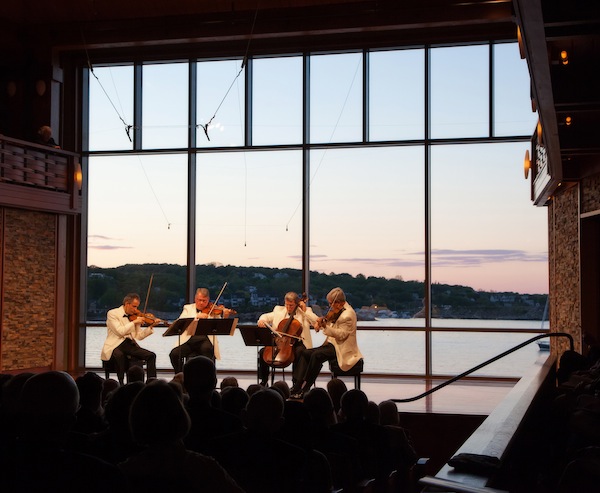Fuse Concert Review: Rockport Chamber Music Festival Presents Death and the Emersons
The challenging viola part takes prominence in Shostakovich’s String Quartet no. 13, highlighting an essential yet oft-unsung voice of a string quartet.
by Cashman Kerr Prince
Earlier this spring, the Emerson String Quartet presented a series of concerts in New York City’s Alice Tully Hall, surveying the late quartets by Shostakovich, Britten, and Mendelssohn, and Schubert’s “Death and the Maiden.” The common denominator is composers meditating on death. For the inaugural concert at the 33rd season of the Rockport Chamber Music Festival Friday night, the Emerson String Quartet packed the Shalin Liu Performance Center for their reprisal of two of these works: Shostakovich’s String Quartet no. 13 in b♭, op. 138; and Schubert’s Quartet in d, “Death and the Maiden,” D. 810.
Dmitri Shostakovich wrote his thirteenth quartet in 1970, and it expresses many of his own anxieties about his declining health and his own inevitable, imminent, demise. In three movements and spanning nineteen minutes, this quartet fits outside the now-usual string quartet repertoire. The challenging viola part takes prominence, highlighting an essential yet oft-unsung voice of a string quartet. The Emerson’s Lawrence Dutton rose to the challenges of this part and gave a magisterial performance, from the opening solo that launches the Adagio through the Doppio movimento to the virtuosic end of the concluding Tempo primo.
For much of this quartet individual voices predominate, and the harmonic or contrapuntal sections tend to be spare. This is music of quiet anguish with violently strong outbursts. It is not sarcastic or manic, as we hear in some of Shostakovich’s symphonies; this is a ponderous, deep meditation that puts me in mind of the Buddhist principle of samsara, the pain and suffering of life and fear of death. The knocking of bows against the wood of the instruments recalled themes of Fate in the hands of other composers. Here, though, the dance of death only holds itself together for short phrases as Shostakovich denies himself, and us, any easy resolution. Nods to other deathly motifs enrich but never deter Shostakovich from his own sublime message: the ineffable monumentality of it all. The Emerson String Quartet, which recorded this work, has lived with this music for a long time and they thoroughly inhabit this soundscape, bringing the depth of this music to visceral life. This reading was, by turns, reflective and anguished, but always gripping. The technical challenges were despatched handily, as we expect from this group, and the musical decisions were all carefully considered and well chosen. The results were profoundly moving.
The second work on this shortened program—another exploration of death but this time in a very different idiom—was Franz Schubert’s “Death and the Maiden” (1824 – 1826). Twice as long as the opening Shostakovich quartet, recurring themes bind this music together. The second movement Andante con moto is a theme and variations on Schubert’s well-known song “Der Tod und das Mädchen” (a setting for poem by Matthias Claudius), but in instrumental guise it is rendered with a very different affect. The opening Allegro is dramatic, but the Emersons maintained a great sense of interiority in this music, with the propulsive triplets present, of course, but they did not gallop away with the music. The tempo, which I found slower than other performances and recordings, was ruminative and the contrast when it sped up or slowed down was correspondingly greater—to great effect. The Andante con moto opened in a funereal vein, with the first violin hovering on the precipice of strong emotion, threatening to derail the music but never falling into that quagmire. There was a wide dynamic range in these variations, and a gentle ending to this movement. The Scherzo: Allegro molto was marked by rigorous attacks interspersed with moments of quiescent fragility, while the concluding Presto was a madcap dash to the end, finishing as it were with an invitation: “Come, thou Death, now, quickly.” The Emerson Quartet brought out the thematic unity across the breadth of this monumental work and gave one of the more cohesive and persuasive readings of this familiar work that I can remember hearing.
Recalled to the stage for an encore, they said we had heard enough about death. A sly joke, since they performed the Burlesque from Benjamin Britten’s String Quartet no. 3, op. 94—his own late period meditation on death. As the gloaming descended over Cape Ann, this driven music, obviously influenced by Shostakovich, brought a fitting summary to this concert and sent us all out into the gentle, good night richer for what we had heard.
Cashman Kerr Prince holds degrees in Classics and in Comparative Literature from Wesleyan University, Stanford University, and l’Université de Paris 8 and is currently affiliated with the Department of Classical Studies at Wellesley College. Outside academic circles he is a cellist with the Brookline Symphony Orchestra and also serves on their board. You may have read his concert reviews and articles for The Boston Musical Intelligencer over the last number of years. He is happy to expand his horizons and review theatre, dance, music, and CDs for The Arts Fuse.
Tagged: Cashman Kerr Prince, Emerson Quartet, Rockport Chamber Music Series


